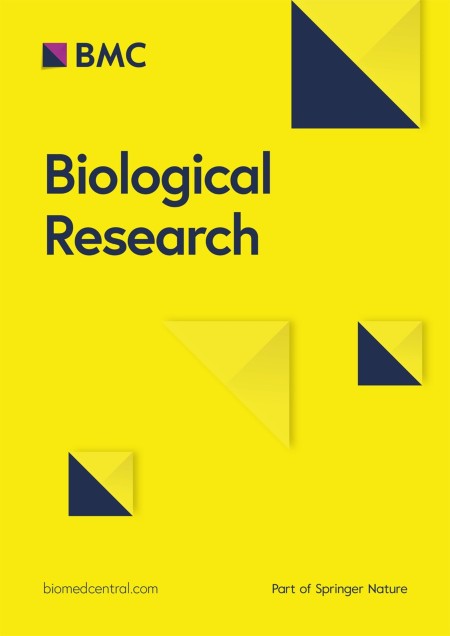智利带有高传播性双碳青霉烯酶质粒的碳青霉烯耐药高病毒性 ST23 肺炎克雷伯菌
IF 4.3
2区 生物学
Q1 BIOLOGY
引用次数: 0
摘要
细菌病原体肺炎克雷伯氏菌(Klebsiella pneumoniae)的高致病性和碳青霉烯类耐药性趋于一致是全球健康关注的一个重要问题。肺炎克雷伯菌(hvKp)菌株通常来自序列 23 型(ST23),具有 K1 包囊,与严重的社区获得性侵袭性感染有关。虽然 hvKp 最初仅限于东南亚地区,而且主要对抗生素敏感,但耐碳青霉烯类的 hvKp 感染在世界各地都有报道。在智利公共卫生研究所领导的碳青霉烯酶生产肠杆菌监测系统中,我们描述了在智利分离到的一株高风险 ST23 双碳青霉烯酶生产 hvKp 菌株,其碳青霉烯酶基因编码在单个共轭质粒中。对该菌株进行的表型和分子检测显示,它对至少 15 种抗生素具有广泛的耐药性,并能产生 KPC-2 和 VIM-1 碳青霉烯酶。意想不到的是,该分离株缺乏高黏度,这对常用的 hvKp 鉴定标准提出了挑战。完整的基因组测序和分析证实了 K1 胶囊型、KpVP-1 毒力质粒以及携带与 hvKp 密切相关的毒力因子的 GIE492 和 ICEKp10 基因组岛。虽然该分离物属于全球传播的 hvKp 克隆组 CG23-I,但它是独一无二的,因为它与之前报道的智利 ST23 hvKp 分离物形成了一个支系,并获得了在南美洲高度传播的 IncN KPC-2 质粒(在其他 hvKp 基因组中不存在),但现在包括一个携带 blaVIM-1 和其他抗性基因的 I 类整合子。值得注意的是,该分离株能够将双碳青霉烯酶质粒连接到大肠杆菌受体上,从而产生对第一代至第五代头孢菌素(包括与β-内酰胺酶抑制剂的组合)、青霉素类、单内酰胺类和碳青霉烯类的耐药性。我们报告了在智利分离出的高风险碳青霉烯类耐药 hvKp,其携带的编码 KPC-2 和 VIM-1 碳青霉烯类酶的高传播性共轭质粒可使其对大多数β-内酰胺类药物产生耐药性。此外,由于缺乏高黏度,这一特征不能作为可靠的 hvKp 标记。这些发现突显了 hvKp 在智利和全球范围内向耐多药方向的快速进化,以及共轭质粒和其他移动遗传因子在这种趋同中的重要性。在这方面,基因组学方法为监测和获取有关这些重点病原体和移动元素的重要信息提供了宝贵的支持。本文章由计算机程序翻译,如有差异,请以英文原文为准。
Carbapenem-resistant hypervirulent ST23 Klebsiella pneumoniae with a highly transmissible dual-carbapenemase plasmid in Chile
The convergence of hypervirulence and carbapenem resistance in the bacterial pathogen Klebsiella pneumoniae represents a critical global health concern. Hypervirulent K. pneumoniae (hvKp) strains, frequently from sequence type 23 (ST23) and having a K1 capsule, have been associated with severe community-acquired invasive infections. Although hvKp were initially restricted to Southeast Asia and primarily antibiotic-sensitive, carbapenem-resistant hvKp infections are reported worldwide. Here, within the carbapenemase production Enterobacterales surveillance system headed by the Chilean Public Health Institute, we describe the isolation in Chile of a high-risk ST23 dual-carbapenemase-producing hvKp strain, which carbapenemase genes are encoded in a single conjugative plasmid. Phenotypic and molecular tests of this strain revealed an extensive resistance to at least 15 antibiotic classes and the production of KPC-2 and VIM-1 carbapenemases. Unexpectedly, this isolate lacked hypermucoviscosity, challenging this commonly used hvKp identification criteria. Complete genome sequencing and analysis confirmed the K1 capsular type, the KpVP-1 virulence plasmid, and the GIE492 and ICEKp10 genomic islands carrying virulence factors strongly associated with hvKp. Although this isolate belonged to the globally disseminated hvKp clonal group CG23-I, it is unique, as it formed a clade apart from a previously reported Chilean ST23 hvKp isolate and acquired an IncN KPC-2 plasmid highly disseminated in South America (absent in other hvKp genomes), but now including a class-I integron carrying blaVIM−1 and other resistance genes. Notably, this isolate was able to conjugate the double carbapenemase plasmid to an E. coli recipient, conferring resistance to 1st -5th generation cephalosporins (including combinations with beta-lactamase inhibitors), penicillins, monobactams, and carbapenems. We reported the isolation in Chile of high-risk carbapenem-resistant hvKp carrying a highly transmissible conjugative plasmid encoding KPC-2 and VIM-1 carbapenemases, conferring resistance to most beta-lactams. Furthermore, the lack of hypermucoviscosity argues against this trait as a reliable hvKp marker. These findings highlight the rapid evolution towards multi-drug resistance of hvKp in Chile and globally, as well as the importance of conjugative plasmids and other mobile genetic elements in this convergence. In this regard, genomic approaches provide valuable support to monitor and obtain essential information on these priority pathogens and mobile elements.
求助全文
通过发布文献求助,成功后即可免费获取论文全文。
去求助
来源期刊

Biological Research
生物-生物学
CiteScore
10.10
自引率
0.00%
发文量
33
审稿时长
>12 weeks
期刊介绍:
Biological Research is an open access, peer-reviewed journal that encompasses diverse fields of experimental biology, such as biochemistry, bioinformatics, biotechnology, cell biology, cancer, chemical biology, developmental biology, evolutionary biology, genetics, genomics, immunology, marine biology, microbiology, molecular biology, neuroscience, plant biology, physiology, stem cell research, structural biology and systems biology.
 求助内容:
求助内容: 应助结果提醒方式:
应助结果提醒方式:


